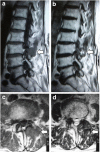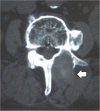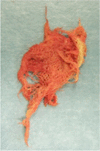Gossypiboma 19 years after laminectomy mimicking a malignant spinal tumour: a case report
- PMID: 25236490
- PMCID: PMC4177374
- DOI: 10.1186/1752-1947-8-311
Gossypiboma 19 years after laminectomy mimicking a malignant spinal tumour: a case report
Abstract
Introduction: Gossypiboma is rare and mostly asymptomatic in chronic cases. It can be confused with other soft tissue masses.
Case presentation: Our patient was an 87-year-old Japanese man with a history of surgery for a lumbar lesion causing lumbar canal stenosis 19 years earlier. Computed tomography showed a soft tissue mass with osteolysis and periosteal thickening of the vertebral lamina. On magnetic resonance imaging, the mass showed heterogeneous signal intensity on T2-weighted imaging, suggesting a malignancy. At the time of biopsy, small pieces of retained surgical sponge were collected. Surgical treatment was performed to excise the soft tissue tumour.
Conclusions: Gossypiboma should be included in the differential diagnosis of soft tissue masses in the paraspinal region in patients with a history of previous spinal surgery.
Figures




References
-
- Hakan T, Aydoseli A, Demir K, Aker F. Clinical, pathological and radiological features of paraspinal textiloma: report of two cases and review of the literature. Neurol Neurochir Pol. 2009;43:475–478. - PubMed
Publication types
MeSH terms
LinkOut - more resources
Full Text Sources
Other Literature Sources
Medical

